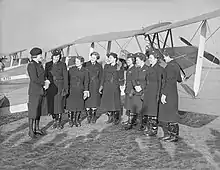Mona Friedlander
Mona Friedlander or Mrs Mona Renee Vera Ernesta Forward (2 June 1914 - December 1993) was a British pilot and one of the eight founding pilots who started the women's section of the Air Transport Auxiliary.[1]
Mona Friedlander | |
|---|---|
.jpg.webp) in 1940 | |
| Born | Mona Renee Vera Ernesta Friedlander 2 June 1914 |
| Died | December 1993 (aged 79) |
| Nationality | United Kingdom |
| Occupation | pilot |
| Known for | founding pilot of the Air Transport Auxiliary |
Life
Friedlander was born in London in 1915. Her father was a rich banker and they lived in Park Lane.[2]
Her parents funded her to gain a pilots license, but they were unwilling to continue when her ambition continued. She wanted to train as a flying instructor. She continued despite her parents by taking a job pulling flying banners for the summer. Some pilots would take off with the banner but Friedlander preferred to fly back at a defined height and pick up the banner.[2] In 1939 she was working for Air Taxis Ltd of Croydon[3] when the government used their powers to move the company to Manchester.[4]
Air Transport Auxiliary

Friedlander was one of the eight founding pilots in the women's section of the Air Transport Auxiliary (ATA).[5][6] Alongside Winifred Crossley Fair, Margaret Cunnison, Hon. Margaret Fairweather, Joan Hughes, Gabrielle Patterson, Rosemary Rees and Marion Wilberforce, they were known as the First Eight, all appointed by Commandant Pauline Gower.[7]
The role was so new that she had to design and then get a tailor to make her uniform. Hers was based on the male uniform but with fewer pockets and in a lighter shade of blue. Friedlander did a lot of night flying as she would fly back and forth along a defined route so that gun batteries could use her plane to practice identifying her range and direction using their listening equipment[2] and pick her out with their searchlights. It was known as Army Cooperation flying.[5] The work was cold and initially she was unable to find a wireless operator to fly with her. Eventually one man proved ambivalent about flying with a woman pilot and after that she had other willing partners.[2][8]
In 1943 she was invalided out of the ATA and she took work as a censor. She was entrusted with inspecting press photographs to decide if they revealed secret information.[3]
In 1985 the Imperial War Museum recorded her biography as an oral history.[3]
Legacy
A bus company in Hatfield named its eight buses after the "first eight" of the Tiger Moth pilots in the ATA, including Friedlander.[9][10] The fifteen surviving women members of the ATA (and 100 surviving male pilots) were given a special award in 2008 by the Prime Minister Gordon Brown.[11]
References
- "Mona Rene V E Forward". England and Wales Death Registration Index 1837-2007. Retrieved 23 June 2020.
- "LONDON SOCIETY GIRL IS ARMY PILOT". Mercury (Hobart, Tas. : 1860 - 1954). 1939-09-01. p. 5. Retrieved 2020-03-02.
- "Forward, Mona Renee Vera Ernesta (Oral history)". Imperial War Museums. Retrieved 2020-03-02.
- "Air Taxis". www.airportofcroydon.com. Retrieved 2020-03-02.
- "ATA First Eight". www.airtransportaux.com. Retrieved 2020-03-02.
- Fort, Hugh (2020-03-08). "The extraordinary women who risked their lives during World War Two". getreading. Retrieved 2020-03-08.
- Poad, Richard (2020-01-14). "ATA's first 8 women pilots". Air Transport Auxiliary. Retrieved 2020-12-30.
- "World War 2 in pictures: Women at war". The Telegraph. 2009-09-21. ISSN 0307-1235. Retrieved 2020-03-08.
- "Inspirational ATA Female Pilots Honoured". Women in Transport. Retrieved 2020-03-01.
- Suslak, Anne. "Uno launches 'Tigermoth' buses in Hatfield named after inspirational female aviators". Welwyn Hatfield Times. Retrieved 2020-03-08.
- "Britain's FEMALE Spitfire pilots to receive badge of courage at last". Evening Standard. 2008-02-21. Retrieved 2020-03-01.